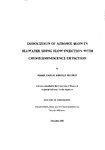DISSOLUTION OF AEROSOL IRON IN SEA WATER USING FLOW-INJECTION WITH CHEMILUMINESCENCE DETECTION
| dc.contributor.author | SEGURET, MARIE JOSIANE MIREILLE | |
| dc.contributor.other | School of Geography, Earth and Environmental Sciences | en_US |
| dc.date.accessioned | 2013-09-17T13:09:40Z | |
| dc.date.available | 2013-09-17T13:09:40Z | |
| dc.date.issued | 2008 | |
| dc.identifier | NOT AVAILABLE | en_US |
| dc.identifier.uri | http://hdl.handle.net/10026.1/1815 | |
| dc.description.abstract |
Iron is an essential micronutrient for the metabolism of marine organisms and impacts on primary productivity and hence indirectly on climate change. The dominant source of iron to the sea surface in open ocean regions is from the atmosphere by aeolian dust transport but the solubility of iron from dust is poorly constrained. In this thesis, chemical and physical factors impacting on the process of dust dissolution and iron release in seawater were investigated using FI-CL detection. A manual FI manifold was automated and optimised for the determination of iron, at nanomolar concentrations, released from aerosols in seawater. The limit of detection was 0.04 ± 0.03 nM and the precision (rsd) ranged from 0.2 to 10.8%. Protocols, maintenance find troubleshooting sections were documented for effective utilisation o f the technique. A seawater treatment system to produce low DOC (dissolved organic carbon) and dFe (dissolved iron) seawater was adapted and optimised. This UV photo-oxidation system was poorly efficient in removing DOC (-40%), complexing ligands (~60%) and dFe (apparent removal 90%). An autosampler was designed, validated, and integrated with an incubation system for sub-sampling during dissolution experiments of aerosol iron in seawater. Fast release of iron f r om the aerosol particles occurred within the first 2 h, followed by a decrease over 1 day. Preliminary experiments w i t h UV-irradiated seawater exhibited lower solubilities compared w i t h non UV-irradiated seawater. High dust concentrations gave lower final solubilities compared with low dust concentrations. A 24 h kinetic study was carried out using NIST 1648 under contrasting light and dark regimes. Dissolution of the endmember under dark conditions released 0.36% of the iron whilst the addition of 20 nM to 200 nM Desferrioxamine B (DFOB) stimulated a release of 0.90 to 1.6%. In light, the release of iron was 0.50% with aerosol, whilst the addition of DFOB (20 nM) induced an adsorption (-1.18%). Iron release from aerosol samples from three sites around the Eastern Mediterranean: Erdemli, Tel-Shikmona and Heraklion was determined in a NATO funded project. The solubility of contrasting aerosol populations from crustal and anthropogenic sources was investigated. Crustally derived aerosol samples exhibited a variable kinetic profile of iron release with an average of maximum solubility of 0.39 ± 0.52%. The anthropogenically influenced aerosol samples exhibited consistent kinetic profiles (fast release < 2 h) with an average of maximum solubility of 10.6 ± 8.9%. From these results, an approximation of the atmospheric dry inputs of soluble iron in seawater to the Levantine Basin was calculated for the first time, ranging from 804 ± 910 t for the Northern Levantine Basin to 2,670 ± 3,050 t for the Southern Levantine Basin. | en_US |
| dc.language.iso | en | en_US |
| dc.publisher | University of Plymouth | en_US |
| dc.title | DISSOLUTION OF AEROSOL IRON IN SEA WATER USING FLOW-INJECTION WITH CHEMILUMINESCENCE DETECTION | en_US |
| dc.type | Thesis | |
| plymouth.version | Full version | en_US |
| dc.identifier.doi | http://dx.doi.org/10.24382/3516 |
Files in this item
This item appears in the following Collection(s)
-
01 Research Theses Main Collection
Research Theses Main


